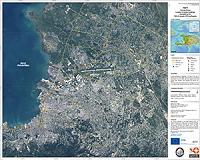 |
Pasadena CA (SPX) Jan 19, 2010 On January 14, 2010, the Advanced Spaceborne Thermal Emission and Reflection Radiometer (ASTER) instrument on NASA's Terra spacecraft captured this simulated natural color image of the Port-au-Prince, Haiti, area, two days after a magnitude 7.0 earthquake struck the region and caused massive damage and loss of life. While ASTER's 15-meter (50-foot) resolution is not sufficient to see damaged buildings, it can be used to identify other results of the shaking. The red circles superimposed on the image indicate possible landslides, a common occurrence in mountainous terrain after large earthquakes. The possible landslides were identified by carefully comparing the new image with an image acquired one year previously. With its 14 spectral bands from the visible to the thermal infrared wavelength region and its high spatial resolution of 15 to 90 meters (about 50 to 300 feet), ASTER images Earth to map and monitor the changing surface of our planet. ASTER is one of five Earth-observing instruments launched December 18, 1999, on NASA's Terra satellite. The instrument was built by Japan's Ministry of Economy, Trade and Industry. A joint U.S./Japan science team is responsible for validation and calibration of the instrument and the data products. The broad spectral coverage and high spectral resolution of ASTER provide scientists in numerous disciplines with critical information for surface mapping and monitoring of dynamic conditions and temporal change. Example applications include monitoring glacial advances and retreats; monitoring potentially active volcanoes; identifying crop stress; determining cloud morphology and physical properties; wetlands evaluation; thermal pollution monitoring; coral reef degradation; surface temperature mapping of soils and geology; and measuring surface heat balance. The U.S. science team is located at NASA's Jet Propulsion Laboratory, Pasadena, Calif. The Terra mission is part of NASA's Science Mission Directorate, Washington, D.C. Image acquired: January 14, 2010 Area covered: 50.6 by 49 kilometers (31.4 by 30.4 miles) Location of image: 18.5 degrees North latitude, 72.5 degrees West longitude Image resolution: 15 meters (50 feet)
Share This Article With Planet Earth
Related Links Advanced Spaceborne Thermal Emission and Reflection Radiometer (ASTER) Earth Observation News - Suppiliers, Technology and Application
 Global satellites unite over Haiti to help in rescue work
Global satellites unite over Haiti to help in rescue workParis (AFP) Jan 15, 2010 Some 20 satellites are trained on Haiti taking images to help in rescue efforts after the devastating earthquake there as part of a decade-old agreement to share such data in the wake of disasters. "There is really a strong international collaboration like there was at the time of the 2004 tsunami in Asia or Hurricane Katrina," a year later, said Andre Husson of the French space agency. ... read more |
|
| The content herein, unless otherwise known to be public domain, are Copyright 1995-2009 - SpaceDaily. AFP and UPI Wire Stories are copyright Agence France-Presse and United Press International. ESA Portal Reports are copyright European Space Agency. All NASA sourced material is public domain. Additional copyrights may apply in whole or part to other bona fide parties. Advertising does not imply endorsement,agreement or approval of any opinions, statements or information provided by SpaceDaily on any Web page published or hosted by SpaceDaily. Privacy Statement |